Google Analytics is the website and marketing measurement platform of choice for many.
New reports and tools are added on a regular basis. Plus, we can connect other Google data products such as Search Console and Google Ads.
Those are important, as well as taking the step of configuring the settings for your specific site.
I encourage you to fully explore the ways to fully unlock the data potential.
That could mean configuring conversion tracking through goals, event tracking significant actions you want to track within pages, connecting the other Google products I mentioned, getting to know other settings and more.
Those are great first steps.
Now, let’s take a deep dive into 11 specific Google Analytics reports you might not know about. These could be the key to valuable insights you can leverage in your website and marketing efforts.
1. Custom Dashboards
How many times do you jump into Google Analytics to find the same report, stats, or slice of data?
How many times do you have to answer the same question for a stakeholder?
If more than once, then custom dashboards are for you.
You can create custom dashboards from pretty much any data view you can drill down into in Google Analytics. Plus, you can add data and reports in widget format from multiple reports into one page.
This is a big time saver. It can also be scheduled for automatic export and delivery to you or key stakeholders once you have it set up the way you want it.
This is a great starting point before jumping over to Google Data Studio, where you can do even more.
-
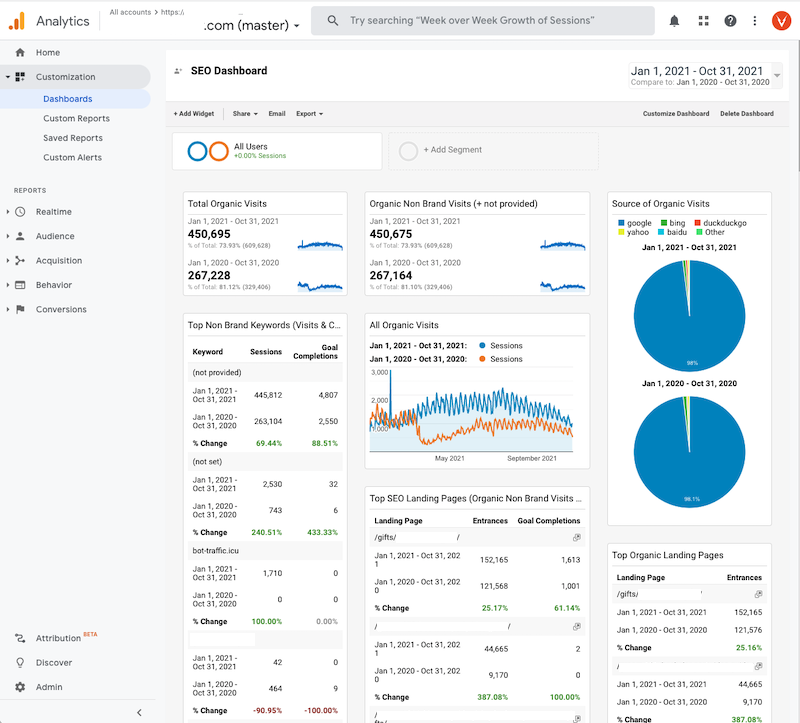 Screenshot by author, November 2021
Screenshot by author, November 2021
2. Lifetime Value
This report still has the “beta” tag in Google Analytics. However, over time, I’ve found more use for it in sites that have a lot of engagement within the 30-90 day cookie window that Google Analytics can track.
If you have a site that engages users and that they return to often to make one or more purchases, you can track the value of specific users and factor this in with other aspects of the buyer’s journey that you’re measuring.
Note that when something is in beta, I keep in mind that the report could be updated, enhanced, removed, or that data could change over time, so beware.
-
 Screenshot by author, November 2021
Screenshot by author, November 2021
3. User Explorer
User explorer allows us to drill down into the journeys of specific website visitors.
While we can’t personally identify the user in Google Analytics by default (and be careful if you try to match up data as Google has specific guidelines on this), we see how individual users consumed content and acted within the website over a period of time.
-
 Screenshot by author, November 2021
Screenshot by author, November 2021
This information isn’t necessarily as powerful as some third-party user recording and heat mapping tools but it provides some aggregation and insight that rolls up revenue data and other standard Google Analytics metrics in a single report.
Being able to see individual user journeys – including the number of sessions, what pages/activities they did during them, and ultimately when they purchase or make a decision – can help with user experience and conversion rate optimization.
It can also help set expectations for marketing activities and how many steps are realistically part of the customer journey.
-
 Screenshot by author, November 2021
Screenshot by author, November 2021
4. Interests/Affinity Categories
The Interests/Affinity Categories report can be really interesting and helpful across a wide range of uses.
If you don’t see data by default, you have to simply agree to the terms and give Google authorization to show it for your account.
The categories shown may or may not align with what you expect.
You can leverage these categories by:
- Further drilling down into them to understand behavior.
- Sharing this data with those running paid search or social media campaigns and writing content targeting specific audiences.
- Comparing the segments to each other.
Finding opportunities to leverage specific audiences and segments is powerful when tuning your content strategy.
This data provides a lot of options for adding dimensions and slicing and dicing the views. It can be a great starting point for spending some in-depth time looking at:
- Who your current audience really is.
- How they convert.
- Where you should prioritize your efforts across the digital marketing spectrum.
-
 Screenshot by author, November 2021
Screenshot by author, November 2021
5. Benchmarking – Channels
If you’ve ever wondered or been asked about how your website performance compares to others in your industry, the benchmark report is a hidden gem that can help.
You can select some pretty detailed industry verticals and see how your site compares across the different channels in the standard Google Analytics traffic metrics.
This is great data to use to set a baseline and establish goals if you’re struggling to determine how to do so.
It can be a lot more helpful and fun to put some real competitive targets in place rather than looking inward or arbitrarily setting goals that may or may not be realistic.
-
 Screenshot by author, November 2021
Screenshot by author, November 2021
6. Users Flow
This report has visually overwhelmed me for a long time. At first glance, it looks busy and hard to decipher.
Give it a moment, though, and use the zoom slider and move around the page. Also, use the dropdown above the first column to change the dimensions you want to review.
Once you get the hang of it, this page can provide some solid insight in a way that you would have to drill down through level after level in other reports to get the same info.
Seeing how your users navigate through the site in aggregate and the popular paths can lead to further investigation if there are surprises.
You can also see patterns and tendencies in the user journey to help you shape your content to shape changes in the paths over time.
-
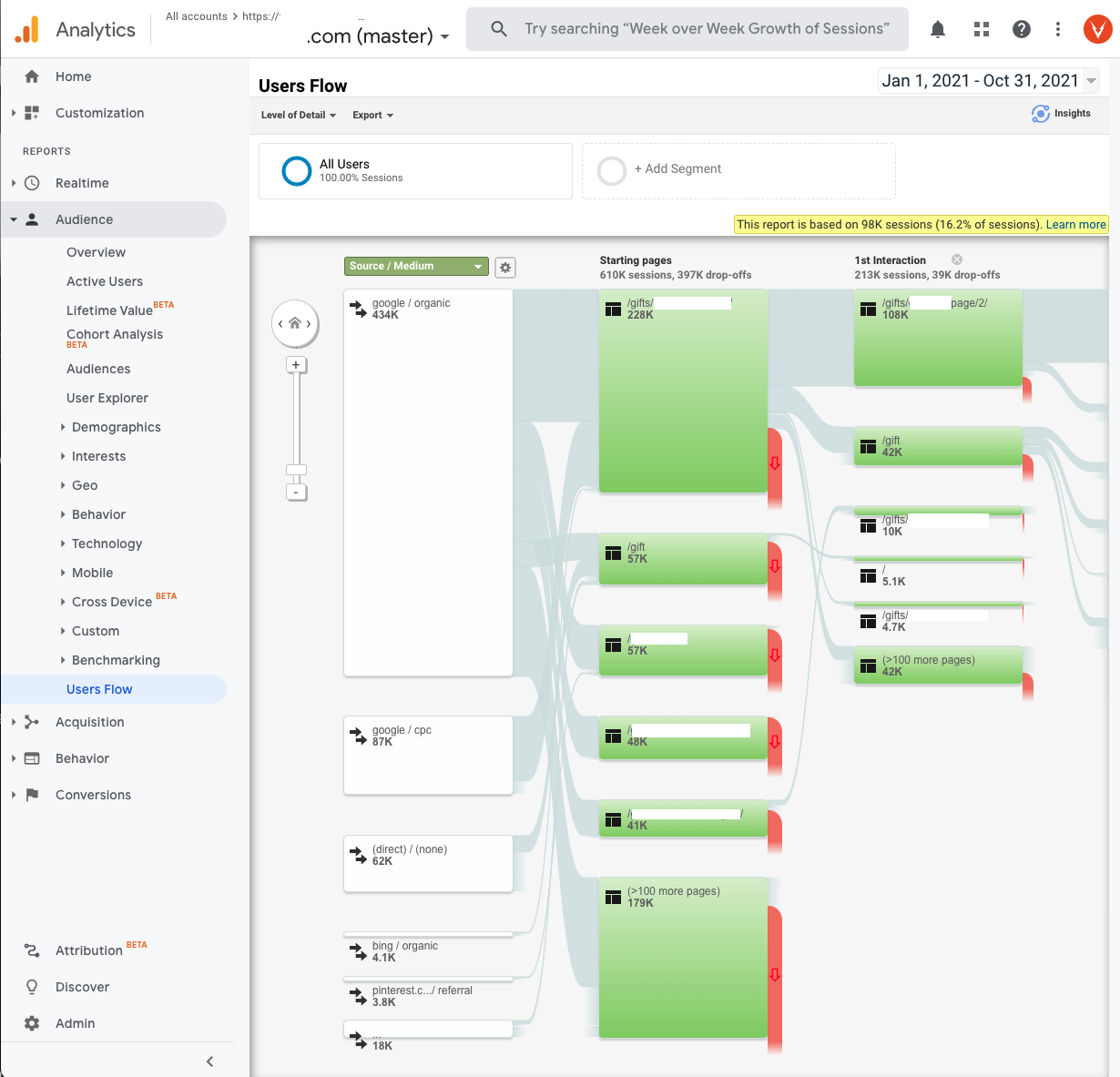 Screenshot by author, November 2021
Screenshot by author, November 2021
7. Site Content – Landing Pages
While pretty basic, this report is often overlooked.
Knowing the top landing pages for your website can help validate and connect the dots between specific marketing efforts, organic search, viral content, and more.
By using the dimension tools you can also see the source for each page and quickly know what is driving the most traffic to it.
For SEOs, you want to confirm that over time you’re getting a diversified set of landing pages based on your optimization strategy.
Chances are that you aren’t trying to drive all traffic to and through the home page.
You want to have as many landing pages possible as entry points for the most relevant traffic topically to be entering through them respectively.
-
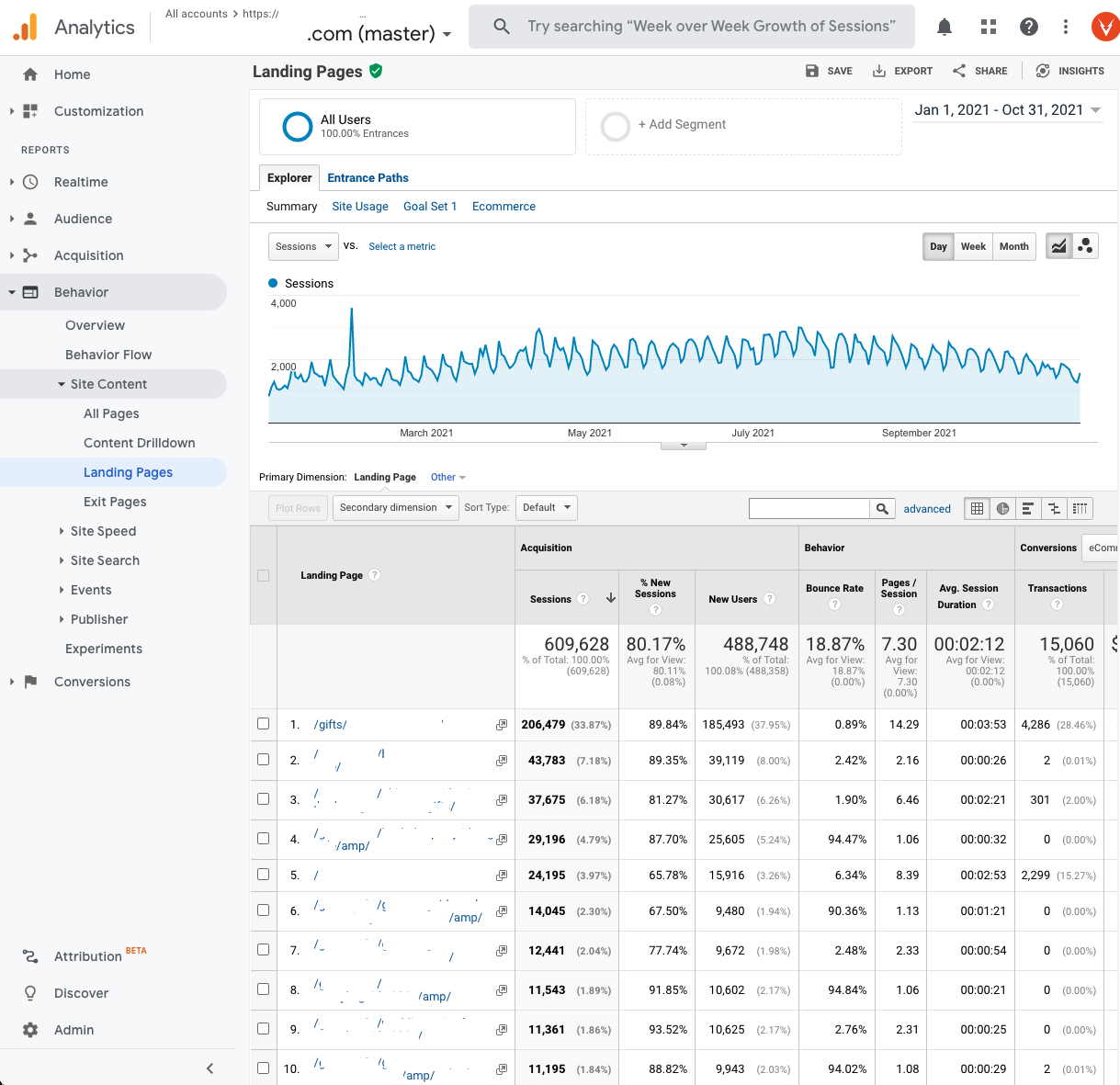 Screenshot by author, November 2021
Screenshot by author, November 2021
8. Site Search – Search Terms
While most content management systems and ecommerce platforms provide reporting on what terms are being searched through on-site search functions, Google Analytics can help you dig deeper.
With the Google Analytics search terms report, you can see the same terms your web platform likely shows you.
From there, you can also apply all of the typical Google Analytics dimensions and see more about the users’ source, behavior, and what they did on the site in a much more extensive and detailed way.
You can then use this data for UX, CRO, and other improvements to make content easier to find and ensure your search is working as intended.
-
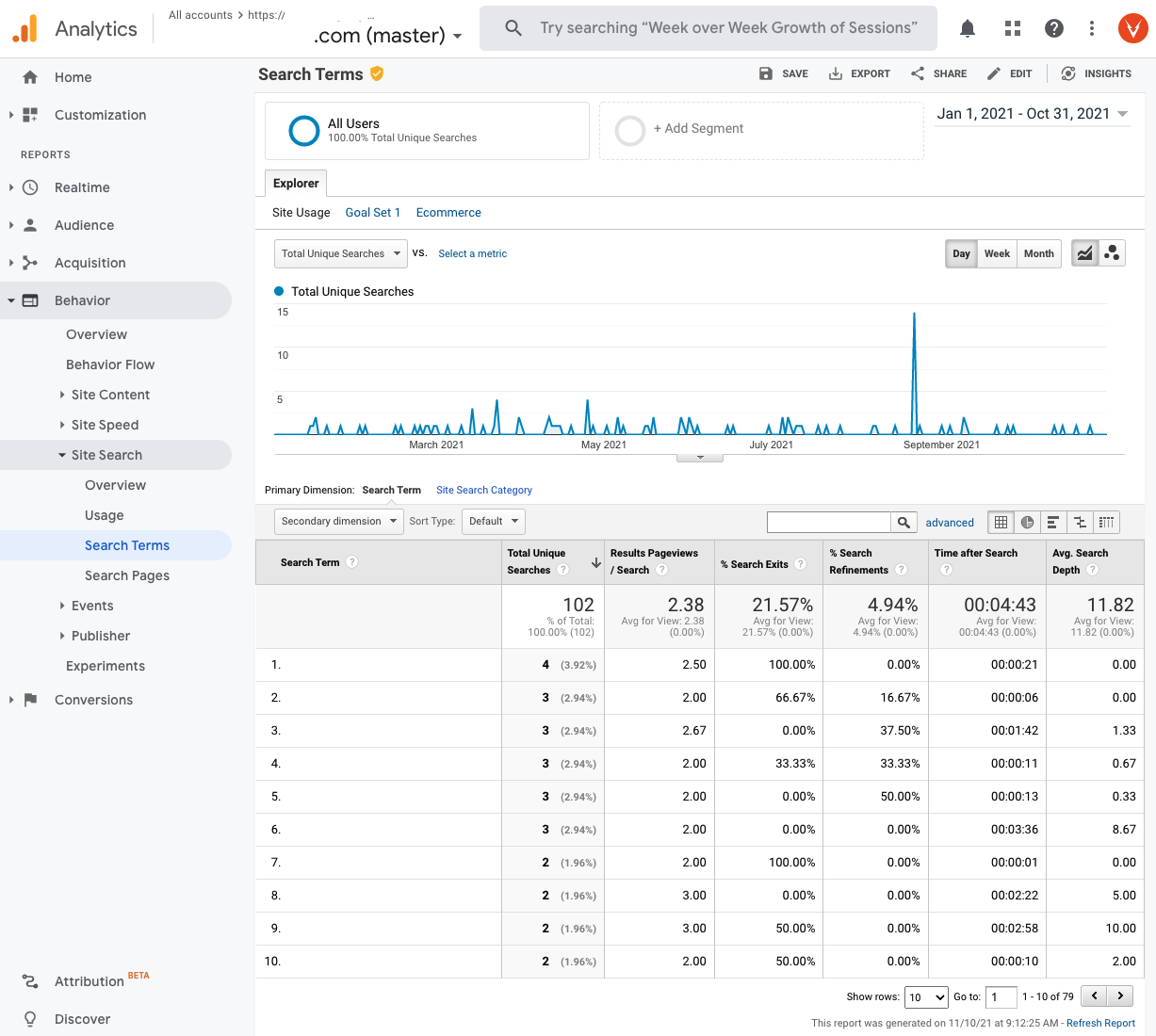 Screenshot by author, November 2021
Screenshot by author, November 2021
9. Multi-Channel Funnels – Assisted Conversions
In many, if not most instances, lead submission or ecommerce purchase goal conversions don’t happen on the first visit. Being able to give credit to visits prior to the visit where the conversion happened is powerful.
Google Analytics provides an assisted conversions report to show us how each channel is involved in the journey when not responsible for the actual conversion visit.
In some cases, you’ll see the same channel as the bulk of your last-click conversions. However, being able to give credit where it is due is important.
For example, you may be getting ready to write off a specific channel like social as it isn’t driving any leads or revenue.
But the assisted conversion report (plus others showing user paths and journeys) may tell you otherwise.
The great part of having revenue tracking set up is that you can see dollar amounts tied to the specific traffic and how much the assists are worth in helping close the deal.
-
 Screenshot by author, November 2021
Screenshot by author, November 2021
10. Multi-Channel Funnels – Top Conversion Paths
Going a step further than assisted conversions, we can see aggregated data showing the most popular mixes and orders of channels leading to conversions in the customer journey.
This is again another powerful way to see how the channels work together and what revenue comes from it.
-
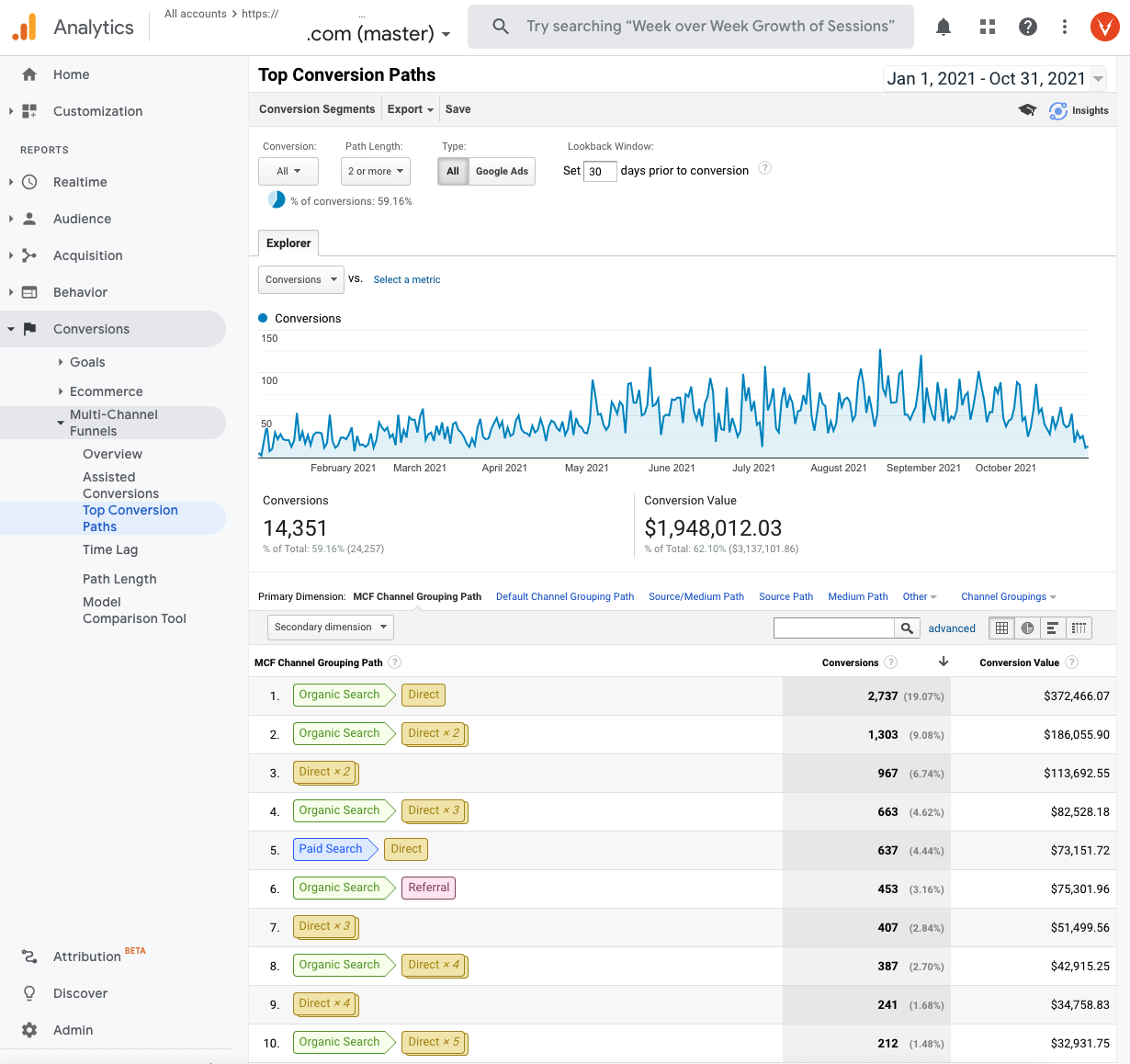 Screenshot by author, November 2021
Screenshot by author, November 2021
11. Attribution – Model Comparison Tool
Attribution has been a top concern of digital marketers for a long time.
Google Analytics provides a tool to compare the different models like first-click against the default of last-click. You can even find other models, import them, and create your own to suit your business needs.
Knowing this report exists and how the different models show your data is a great first step that Google Analytics provides for us.
-
 Screenshot by author, November 2021
Screenshot by author, November 2021
Conclusion
There are a lot of reasons we don’t have time to live in Google Analytics and stay on top of all of the reports and data it holds.
I’m not saying that you need to invest a significant amount of new time in there.
However, I do want to push you to take a moment to consider the reports that you may not know about or that you may not currently utilize.
There are a lot of great ways to have this data integrated into third-party reporting platforms or to come to you in a custom dashboard.
I’m all about working smarter and not harder. Make sure you have all the information that is relevant to your business or organization.
Don’t overlook the lesser-used or known reports in GA as there’s a lot of power in knowing more of your customer’s journey, behavior, and acquisition to set new goals and shape your future.
More Resources:
- A Complete Guide to Google Analytics
- 5 Useful SEO Insights You Can Learn from Google Analytics
- How to Set up Google Analytics Goals & 7 Tips to Get Ahead
Featured image: Shutterstock/Fonstra





![AI Overviews: We Reverse-Engineered Them So You Don't Have To [+ What You Need To Do Next]](https://www.searchenginejournal.com/wp-content/uploads/2025/04/sidebar1x-455.png)